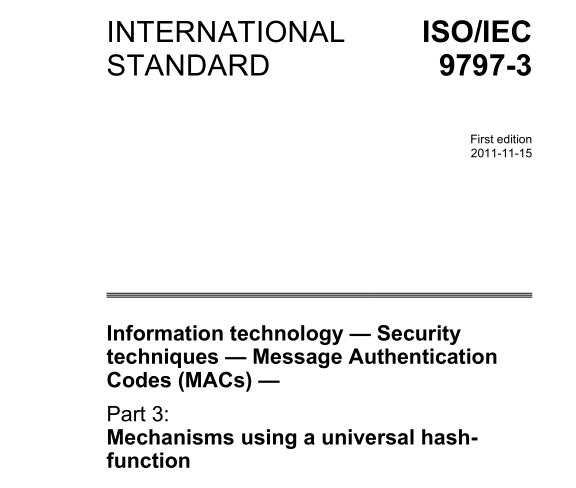ISO IEC 9797-3:2011 pdfダウンロード

ISO IEC 9797-3:2011 pdfダウンロード。Information technology — Security techniques — Message Authentication Codes (MACs) — Part 3: Mechanisms using a universal hash- function
1 Scope
This part of ISO/IEC 9797 specifies the following MAC algorithms that use a secret key and a universal hash-function with an n-bit result to calculate an m-bit MAC based on the block ciphers specified inISO/IEC 18033-3 and the stream ciphers specified in ISO/IEC 18033-4:
a) UMAC;
b) Badger;
c) Poly1305-AES;
d) GMAC.
2 Normative references
The following referenced documents are indispensable for the application of this document. For dated references, only the edition cited applies. For undated references, the latest edition of the referenced document (including any amendments) applies.
ISO/IEC 9797-1, Information technology — Security techniques — Message Authentication Codes (MACs) — Part 1: Mechanisms using a block cipher
ISO/IEC 18031, Information technology — Security techniques — Random bit generation
ISO/IEC 18033-3, Information technology — Security techniques — Encryption algorithms — Part 3: Block ciphers
ISO/IEC 18033-4, Information technology — Security techniques — Encryption algorithms — Part 4: Stream ciphers
3 Terms and definitions
For the purposes of this document, the terms and definitions given in ISO/IEC 9797-1 and the following apply.
3.1
empty string
string of symbols of length zero
3.2
key
sequence of symbols that controls the operation of a cryptographic transformation
3.3
nonce
number used once
3.4
prime number
positive integer greater than 1 which has no integer divisors other than 1 and itself
3.5
tag
result of a MAC algorithm, adjoined to a possibly encrypted message to provide integrity protection
3.6
universal hash-function
function mapping strings of bits to fixed-length strings of bits, indexed by a parameter called the key, satisfying the property that for all distinct inputs, the probability over all keys that the outputs collide is small
NOTE Universal hash-functions were introduced by Carter and Wegman [4] , and their application in MAC algorithms was first described by Wegman and Carter
[10] .
4 Symbols and abbreviated terms
The following notation is used in this part of ISO/IEC 9797:
bit(S,n) Returns the integer 1 if the n th bit of the string S is 1, otherwise returns the integer 0 (indices begin at 1).
bitlength(S) Length of a string S in bits.
bitstr2uint(S) The non-negative integer whose binary representation is the string S. More formally, if S is t bits long then bitstr2uint(S) = 2 t-1 * bit(S,1) + 2 t-2 * bit(S,2) + … + 2 1 * bit(S,t-1) + bit(S,t).
NOTE Bit strings are treated big-endian, i.e. the first bit is the most significant.
blocklen Block length of the underlying block cipher in octets.
- Previous:ISO IEC 1001:2012 pdfダウンロード
- Next:ISO IEC 10646:2012 pdfダウンロード